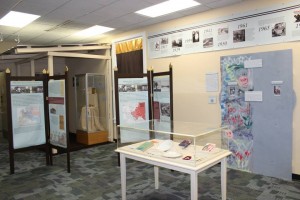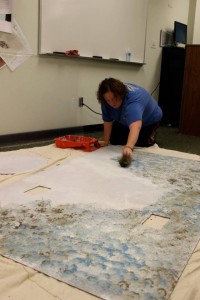Graduate student project award: Push and Pull
15 April 2015 – editors
Editor’s Note: This series showcases the winners of the National Council on Public History’s awards for the best new work in the field. Today’s post is by Beth Bullock, Jayd Buteaux, and Leslie Morton, students in the Public History Program at the University of North Carolina-Wilmington.
The exhibit Push and Pull: Eastern European and Russian Migration to the Cape Fear Region introduces visitors to people such as Ann Mizerak, a descendant of Eastern European immigrants, and Roza Starodubtseva, a recent migrant from St. Petersburg. The exhibit shares their personal stories through narratives and personal belongings and benefits from the involvement of the immigrant community both in St. Helena, a small village that was founded as an immigrant farm colony, and in the city of Wilmington, North Carolina. The immigrant community was involved in all aspects of exhibit research and design, and the dependency on shared authority is evident in the exhibition’s focus on the their words and stories via direct quotes, QR codes linked to both audio and video, and personal artifacts. The ability to see and hear the words of the Russian and Eastern European immigrants has led to a powerful dialogue about culture, family traditions, modern immigration policies, stereotypes, media representations, and current events.
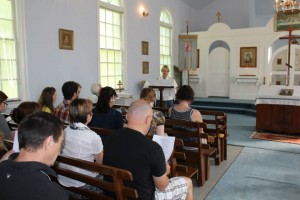
The exhibit team met the advisory committee for the first time at the beginning of the year-long project. Members shared the history of St. Helena and their individual stories over a traditional Eastern European and Russian meal. Photo credit: Jayd Buteaux
The first component of the project involved collecting oral histories from individuals who are part of the local Eastern European and Russian immigrant community. They explained the myriad reasons for migrating to the Cape Fear Region, their expectations of America, and their lives after immigration. Anne Mizerak, whose parents immigrated to St. Helena, North Carolina, in the 1910s, recalled how her father thought life would be much easier here, but upon arrival, he realized “the streets were not paved with gold.” Dorothy Lemoine recalled that, as a child, she was teased by other schoolchildren for her accent. Roza Starodubtseva, along with her family, emigrated from Russia in the 1990s. Roza comically recounted her initial concerns about moving, explaining that her perception of the United States was almost solely based on the movie Pretty Woman–a land full of crime and prostitutes. We used the stories shared during these intimate interviews to people our exhibit.
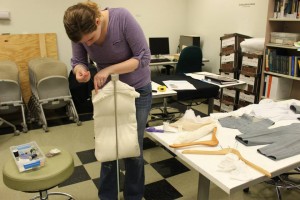
Beth Bullock crafts the mount for the suit, a integral part of “For Love or Money?” as it helps to explain some of the challenges faced by post-Soviet immigrants. Photo credit Jayd Buteaux
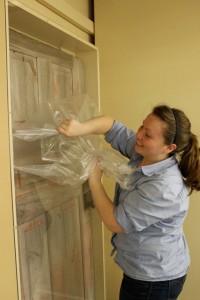
Jayd Buteaux puts the finishing touches on the door, an integral part of “The Streets Were Not Paved With Gold…” as it helps to tell the story of the St. Helena migrants. Photo credit: Jayd Buteaux
A material culture survey similarly involved shared authority as we turned to the community for the tangible side of migration that would allow us to better understand its history. We asked for personal items they were willing to loan the exhibit and the significance these items hold. Some objects did not obviously relate to the story of migration. However, through their personal connections, they shed light on experiences, motivations, and important cultural values that Russian and Eastern European immigrants shared in their American journey. These artifacts also connect to larger themes found in scholarship about Russian and Eastern European motivations for migration. A door from an original St. Helena farming cabin spoke to the lives of the region’s earliest Eastern European migrants and their search for new opportunities in North Carolina. A collection of books, mostly children’s stories, brought by the Starodubtsev family when they migrated from St. Petersburg, demonstrated their efforts to instill and maintain Russian language and culture in their three children. A rug handmade by Roza Starodubtsev’s grandmother as a wedding present highlighted the importance of family ties and heritage, especially in the context of the limited number of possessions the family could bring. A small suitcase brought by the Starodubtsev family made those limitations visible.
Shared authority was not only involved in the research phase but was also integral to the design process. Shared authority in practice meant that we were never alone in curating the exhibit. Other highly invested people were eager to share their memories, their histories, and their time. Working with a community rather than simply for a community allowed us to forge relationships that enhanced the exhibit design, broadened the scope of the dialogue, and bolstered the overall impact of the exhibit.
An advisory committee gave feedback during the material culture survey, interpretive planning, and design process. The committee included immigrants, as well as Russian language and history professors. The advisory committee fostered honest discussions of educational goals, exhibit tone, and themes that resonated clearest and loudest. Design elements began to take shape from the advisory committee’s rich advice and our diligent research. We chose Russian blue, warm chocolate browns, and magnificent golds for our palette–careful to avoid stereotypical colors like red and grey. The people we knew were warm, funny, caring, and anything but stereotypical, and we wanted our exhibit to reflect that in style as well as content.
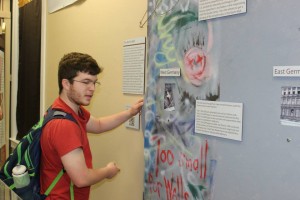
Visitor to the first opening of Push and Pull explores the Berlin Wall interactive. Photo credit: Jayd Buteaux
We wanted visitors to engage with Roza, Dorothy, Anne, and others about adjusting to a new country, overcoming stereotypes, and maintaining heritage and culture. From this desire, an important exhibit component developed–the incorporation of oral history quotes. “Voices of Migration” was an integral way for the visitor to connect and get to know the wonderful individuals that we now knew. Some of the quotes provided humor or offered reflection while others underscored section themes. We let them speak for themselves, and through the use of QR codes, visitors could even watch sections of the oral histories. The quotes touched on themes that inspired dialogue between visitors about their own family histories, their feelings about moving and adjustment, and the history of the Cape Fear region.
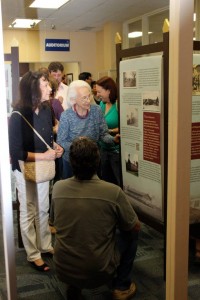
Opening of Push and Pull at the Randall Library Graduate Student Public History Gallery at University of North Carolina-Wilmington. Photo credit: Jayd Buteaux
At the exhibit opening, in late spring 2014, dozens of bodies crammed into our modest exhibition space on UNCW’s campus. There were professors and students, but there was also an abundance of St. Helena community members and proud exhibit participants with their children or grandchildren in tow. Groups of visitors gathered around panels, pointing, talking, laughing, and celebrating the history of this little-known community of immigrants that has lived and worked in the area for almost one hundred years.
In light of developing tensions between Russia and Ukraine, we wanted to provide an outside platform where visitors could extend and deepen the dialogue generated during or after their visit to the exhibit. Enter social media. We created and maintain a Facebook page and Twitter account to keep interested visitors abreast of relevant news from Eastern Europe, as well as providing a dialogue platform. While this may not appeal to our participants and visitors of advanced age, many of the younger visitors, including high school and college students, have responded positively to the social media component.
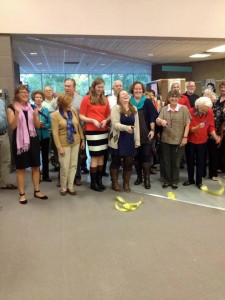
The exhibit team, along with advisory committee members and members of the Pender County community cut the ribbon to officially mark the opening of Push and Pull at the Pender County Library. Photo credit: Jayd Buteaux
The exhibit moved close to the St. Helena community in October 2014 and saw hundreds of visitors during its four-month run at the Pender County Library. A local high school teacher assigned her students a local history project that even included visiting Push and Pull. The high school students’ comments were rewarding. One student recalled her grandparents’ emigration from Europe after they were first married. Another commented that he was now interested in learning about his own family’s heritage. Anne, Rosa, Dorothy, and the other community members were always the caretakers of their histories, and they generously allowed us to tell their stories. There is a pride in this exhibit that is palpable. They made Push and Pull. We were just lucky enough to help them be heard.
~Beth Bullock, Jayd Buteaux, and Leslie Morton are graduate students in the Public History program at the University of North Carolina-Wilmington.




